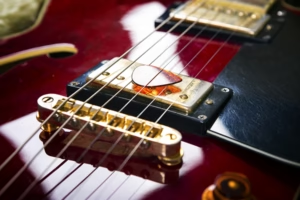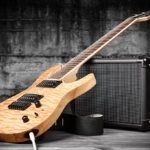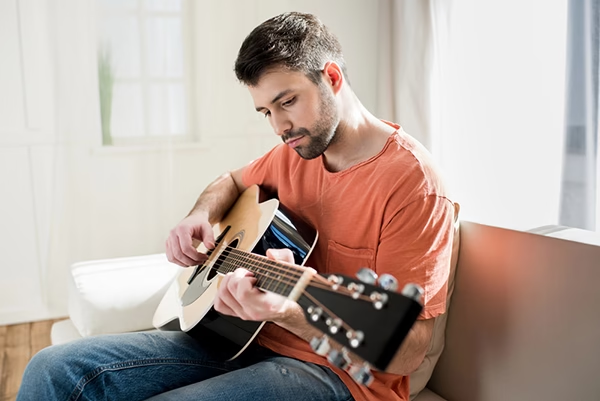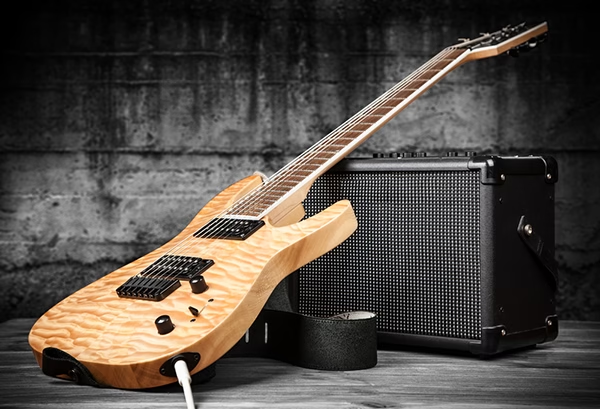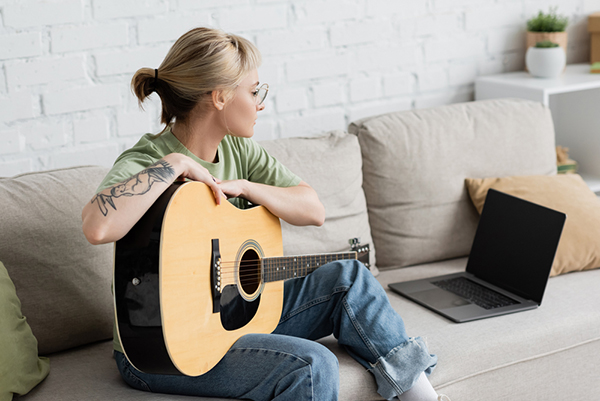
1. Understand Why Learning Guitar Feels Hard—but Isn’t
If you’ve ever wondered how to learn guitar without giving up, you’re not alone. Every beginner faces that awkward phase when chords buzz, fingers ache, and rhythm seems impossible. The truth? Guitar feels hard only at the start because your fingers and brain haven’t built “muscle memory” yet. According to research from the Journal of Research in Music Education, consistent short practice sessions (15–20 minutes daily) lead to faster skill acquisition than marathon sessions once a week.
The biggest early mistake learners make is expecting perfection too soon. Learning guitar is less about talent and more about micro-improvements. Treat each mistake as feedback, not failure. Within a few weeks, your hands will naturally adapt, and you’ll start to feel the rhythm rather than think through every movement.
2. Choose the Right Guitar and Setup
To truly master how to learn guitar, start with the right instrument. Many beginners struggle because they start with a cheap, poorly set-up guitar that fights them at every fret.
Here’s what matters most:
-
Guitar Type: Acoustic guitars build strength and precision. Electric guitars are easier on the fingers and better for modern genres.
-
String Gauge: Light strings (.009 or .010) are ideal for beginners.
-
Action Height: Lower string action makes playing smoother and more enjoyable.
-
Tuning Stability: Invest in a good tuner or use a reliable mobile tuning app.
You don’t need to spend a fortune—a $200–$300 well-setup guitar beats a $1000 guitar that’s improperly tuned. If you’re unsure, visit a local shop and ask them to “set up” your guitar. It’s the best $50 you’ll ever spend.
3. Learn the Core Guitar Shapes and Patterns
When discovering how to learn guitar, focus on chord families and patterns, not random songs. Think of chords as building blocks. The open chords (C, G, D, A, E, and minor versions) are the foundation for thousands of popular songs.
Start by mastering transitions between these chords slowly and cleanly—speed will come later. Next, move to power chords and the pentatonic scale, which opens up soloing and melody playing.
Pro tip: Use the “Four Chord Rule.” Nearly every pop song can be played with G–D–Em–C. Once you can switch between those cleanly, you can play hundreds of songs—and you’ll suddenly feel like a real guitarist.
4. Create a Simple, Repeatable Practice Routine
The secret to how to learn guitar efficiently is structure. Random practice leads to random results. Here’s a proven 30-minute daily plan for beginners:
-
5 minutes: Finger stretches and simple picking patterns
-
10 minutes: Chord transitions (use a metronome)
-
10 minutes: Learn a new riff or part of a song
-
5 minutes: Play for fun—anything you enjoy
Consistency beats intensity. Practicing even 10 minutes daily builds stronger neural pathways than playing two hours once a week. Keep a practice journal and celebrate small wins, like playing a clean G chord or nailing your first song.
5. Train Your Ear and Rhythm Early
A critical but often ignored part of how to learn guitar is ear training. Great guitarists don’t just memorize tabs—they hear intervals, recognize chord progressions, and sense timing intuitively.
To develop this skill:
-
Play along with songs at half-speed (YouTube and Spotify allow tempo control).
-
Clap or tap to the beat before strumming.
-
Use apps like Functional Ear Trainer or Complete Music Reading Trainer.
Also, practice with a metronome—your best invisible teacher. Start slow (60 BPM) and increase by 5 BPM once you play cleanly three times in a row. This habit trains rhythm precision and improves your overall feel for music.
6. Learn Songs You Love—Not Just Exercises
If you want to stay motivated while learning how to learn guitar, don’t just practice drills—play real songs. Research from Frontiers in Psychology shows that emotional connection to the music you practice increases dopamine levels, which strengthens learning retention.
Start with simple songs using basic open chords. Classics like:
-
“Wonderwall” – Oasis
-
“Horse with No Name” – America
-
“Knockin’ on Heaven’s Door” – Bob Dylan
-
“Perfect” – Ed Sheeran
Playing songs you love transforms practice into joy. Every chord progression becomes meaningful. This emotional link is the fastest motivator for sustained learning.
7. Use the Right Learning Resources and Community
The internet has revolutionized how to learn guitar, but it can also overwhelm beginners. Stick to structured, reputable sources instead of endless YouTube rabbit holes.
Here’s what works best:
-
Apps: JustinGuitar, Fender Play, or Yousician—these guide you step-by-step.
-
YouTube Channels: Marty Music and Andy Guitar offer clear tutorials for beginners.
-
Books: “Hal Leonard Guitar Method” and “Guitar Aerobics” build strong foundations.
-
Online Communities: Join r/guitar on Reddit or Facebook groups for support, feedback, and encouragement.
Bonus tip: Record yourself weekly. Hearing your own progress helps you notice subtle improvements and keeps motivation high.
8. Build Calluses, Confidence, and Creativity
Physical discomfort is part of learning. But here’s the silver lining: as you keep practicing how to learn guitar, your fingertips develop calluses, and your strumming arm gets stronger. Pain turns into progress.
Don’t forget the mental game—guitar is 50% mindset. Set tiny goals, like learning one riff or chord per day. By month three, you’ll play confidently. By month six, you’ll jam with others. By year one, you’ll sound like the person who inspired you to pick up the guitar in the first place.
Creativity grows with comfort. Once you’re familiar with chord shapes, start improvising—change rhythms, add fingerpicking, or write a few bars of your own song. Every guitarist, even the legends, started by experimenting with something that didn’t sound right… until it did.
9. Embrace Technology to Accelerate Learning
Modern tools have made how to learn guitar faster than ever:
-
Looper pedals let you record and layer your playing to practice lead and rhythm together.
-
DAWs (Digital Audio Workstations) like GarageBand or Reaper help track progress.
-
AI tutors can analyze your playing accuracy and give instant feedback.
Recording yourself and tracking mistakes helps you progress 10x faster. And when you finally get that one perfect take—save it. That’s your milestone moment.
10. Stay Consistent—Your Future Self Will Thank You
The final truth about how to learn guitar is that there’s no finish line—only progress. Every strum, even a clumsy one, is data for your brain to refine. Consistency is the real teacher.
Celebrate every small win: your first clean chord, your first full song, your first jam with friends. Learning guitar is about joy, connection, and expression—not perfection.
If you dedicate even 20 minutes a day for 90 days, you’ll play fluently enough to impress yourself and others. Keep going, and one day, you’ll look back at your early struggles and smile—because you did it.
References
-
Journal of Research in Music Education – Practice Time Study
-
Frontiers in Psychology – Music Learning Motivation Research
-
National Association for Music Education – Skill Acquisition



